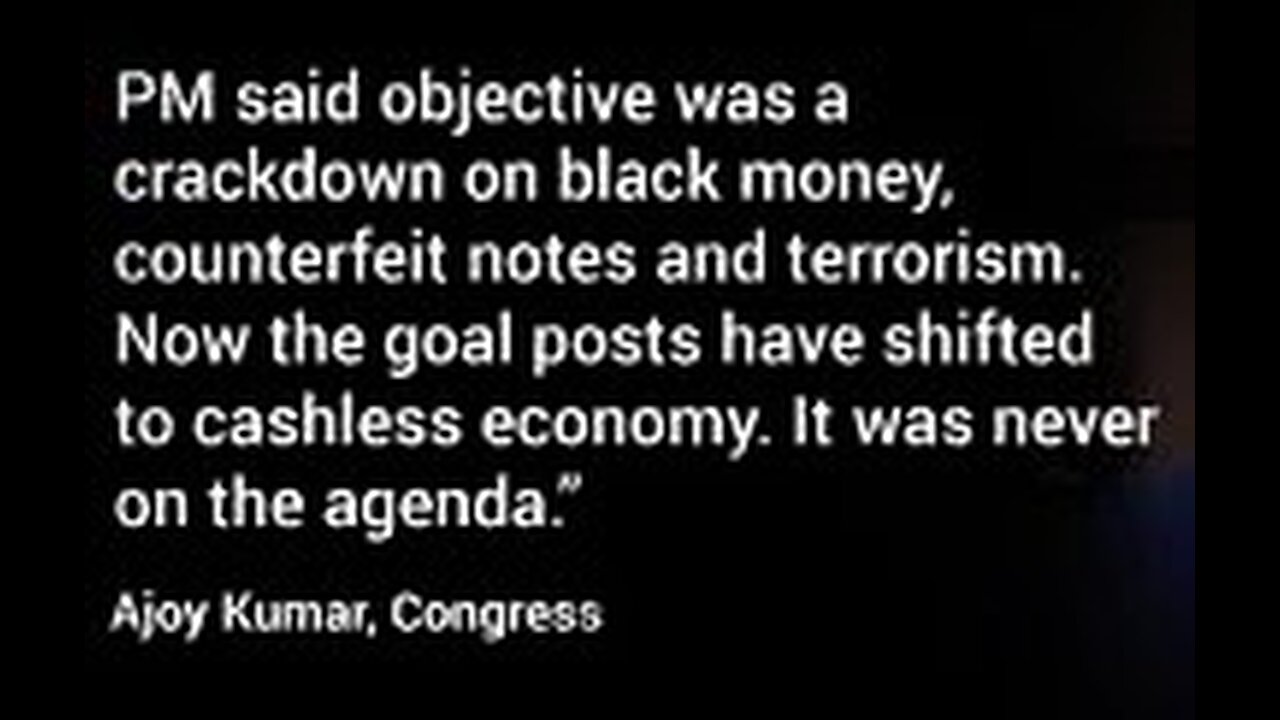Premium Only Content

Biden's Central Bank Digital Currency - Excecutive Order from Hell
The power of central banks, both as issuers of currency and as financial regulators, is easily great enough to ensure that CBDC architecture replaces whatever nascent technologies are currently being built in the crypto space
Central bank digital currencies, or CBDCs, represent the ultimate ratification of digital finance: Its adoption by the most venerated guardians of the international monetary architecture.
Crypto-evangelists often talk about CBDCs in awed terms. But it's far from clear that the bitcoin-and-ethereum crowd would ultimately benefit from money going digital.
How it works: The country with by far the most advanced digital currency is China — but eCNY, as the Chinese digital currency is known, is pretty much the exact opposite of bitcoin and everything it stands for.
It doesn't use blockchain technology. Instead, the ledger of who owns what is closely held at the Chinese central bank — and nowhere else.
While bitcoin is based on zero trust, eCNY requires full trust of the Chinese monetary authorities. If it goes global, then China will at all times know exactly how much of its currency you possess — and could zero you out for any or no reason.
While bitcoin is a deflationary currency designed to increase in value over time, eCNY is an inflationary currency designed to decrease in value over time. In fact, in its current incarnation, it expires worthless if it isn't spent within a few weeks.
The big picture: eCNY is an attempt by China to move toward a monetary and payments system wherein the Communist Party can have full visibility into, and control over, citizens' financial lives.
Other CBDCs won't necessarily go that far. But the ability to keep track of all transactions is part of why they're attractive to central banks that are losing the global war on money laundering.
CBDCs are also attractive to central banks precisely because if they're set up so that they can expire or lose their value over time, that would act as an incentive to spend, in countries that are struggling to reach their target inflation rates.
The power of central banks, both as issuers of currency and as financial regulators, is easily great enough to ensure that CBDC architecture replaces whatever nascent technologies are currently being built in the crypto space.
If that happens, then cryptocurrencies would become little more than digital collectibles — a store of value, perhaps, but one with no real transformative potential.
The value of Bitcoins and NFTs might be dwindling, but a different approach to cryptocurrency is growing in popularity around the world while showcasing a totally different face of the blockchain.
Central bank digital currencies are controlled by governments like traditional currencies are and therefore represent the polar opposite of the idea of decentralized, non-traceable Bitcoins. Several small nations and - since October 2021, Nigeria - have launched central bank digital currencies, and several more populous countries are getting ready to jump aboard a different crypto hype train.
The European Union today is proposing a legal framework for its planned launch of the digital euro.
According to the Central Bank Digital Currency Tracker by Atlantic Council, concrete plans to launch a CBDC were also recorded in Canada, Brazil and the United States, among others.
Countries which are already in a CBDC pilot phase include Russia, Thailand, India, South Korea, Sweden, the United Arab Emirates and Saudi Arabia, according to the source. It is unclear, however, which of these programs could see a proper launch next.
CBDCs were introduced even earlier than in Nigeria in Caribbean countries, for example in the Bahamas and nations and territories that share the currency of the Eastern Caribbean dollar.
The Sand Dollar of the Bahamas was the first central bank digital currency of the world upon its launch in 2019 and cleared the way for a rapid adoption around the region’s small nations.
The Chinese digital Yuan pilot made headlines in April 2019, but the project has not moved on since. Like Nigeria, China has a solid digital and mobile payment infrastructure.
Large parts of the two countries' populations leapfrogged card payments and went straight from cash to digital payment options, which became hugely popular - may they be app or text-based. In developing countries, central banks also consider the potential of digital currencies reaching the unbanked.
Another reason for some governments to champion official digital currencies is the collection of data. Ubiquitous digital payments and tight government surveillance have led to a plethora of payment data already available to Chinese administrators.
This knowledge on how people spend money will only grow with the implementation of the digital Yuan, even though the country’s central bank has said it will limit traceability and create what it calls “controllable anonymity.”
These aspects of digital currencies are viewed negatively by Europeans, who according to a survey by the European Central Bank are concerned about payment privacy in regards to the digital euro.
According to recent reports, the Reserve Bank of India’s (RBI) digital rupee — the Central Bank Digital Currency (CBDC) — may be introduced in phases beginning with wholesale businesses in the current financial year.
RBI had proposed amendments to the Reserve Bank of India Act, 1934, which would enable it to launch a CBDC.
What is Central Bank Digital Currency (CBDC)?
About CBDC:
CBDCs are a digital form of a paper currency and unlike cryptocurrencies that operate in a regulatory vacuum, these are legal tenders issued and backed by a central bank.
It is the same as a fiat currency and is exchangeable one-to-one with the fiat currency.
A fiat currency is a national currency that is not pegged to the price of a commodity such as gold or silver.
The digital fiat currency or CBDC can be transacted using wallets backed by blockchain.
Though the concept of CBDCs was directly inspired by Bitcoin, it is different from decentralised virtual currencies and crypto assets, which are not issued by the state and lack the ‘legal tender’ status.
Objectives:
The main objective is to mitigate the risks and trim costs in handling physical currency, costs of phasing out soiled notes, transportation, insurance and logistics.
It will also wean people away from cryptocurrencies as a means for money transfer.
Bahamas has been the first economy to launch its nationwide CBDC — Sand Dollar.
Nigeria is another country to have rolled out eNaira in 2020.
China became the world's first major economy to pilot a digital currency e-CNY in April 2020.
Korea, Sweden, Jamaica, and Ukraine are some of the countries to have begun testing its digital currency and many more may soon follow.
What are the Benefits & Challenges of CBDC?
Benefits:
A Combination of Traditional and Innovative:
CBDC can gradually bring a cultural shift towards virtual currency by reducing currency handling costs.
CBDC is envisaged to bring in the best of both worlds:
The convenience and security of digital forms like cryptocurrencies
The regulated, reserved-backed money circulation of the traditional banking system.
Easier Cross-Border Payments:
CBDC can provide an easy means to speed up a reliable sovereign backed domestic payment and settlement system partly replacing paper currency.
It could also be used for cross-border payments, it could eliminate the need for an expensive network of correspondent banks to settle cross-border payments.
Financial Inclusion:
The increased use of CBDC could be explored for many other financial activities to push the informal economy into the formal zone to ensure better tax and regulatory compliance.
It can also pave the way for furthering financial inclusion.
Privacy Concerns:
The first issue to tackle is the heightened risk to the privacy of users—given that the central bank could potentially end up handling an enormous amount of data regarding user transactions.
This has serious implications given that digital currencies will not offer users the level of privacy and anonymity offered by transacting in cash.
Compromise of credentials is another major issue.
Disintermediation of Banks:
If sufficiently large and broad-based, the shift to CBDC can impinge upon the bank’s ability to plough back funds into credit intermediation.
If e-cash becomes popular and the Reserve Bank of India (RBI) places no limit on the amount that can be stored in mobile wallets, weaker banks may struggle to retain low-cost deposits.
Other risks are:
Faster obsolescence of technology could pose a threat to the CBDC ecosystem calling for higher costs of upgradation.
Operational risks of intermediaries as the staff will have to be retrained and groomed to work in the CBDC environment.
Elevated cyber security risks, vulnerability testing and the costs of protecting the firewalls.
Operational burden and costs for the central bank in managing CBDC.
In order to obviate some weaknesses of CBDCs, the usage should be payment-focused to improve the payment and settlement system.
Then it can steer away from serving as a store of value to avoid the risks of disintermediation and its major monetary policy implications.
The data stored with the central bank in a centralised system will hold grave security risks, and robust data security systems will have to be set up to prevent data breaches.
Thus, it is important to employ the right technology that will back the issue of CBDCs.
The sizing of the infrastructure required for the CBDC will remain tricky if payment transactions are carried out using the same system.
The RBI will have to map the technology landscape thoroughly and proceed cautiously with picking the correct technology for introducing CBDCs.
The financial data collected on digital currency transactions will be sensitive in nature, and the government will have to carefully think through the regulatory design.
This would require close interaction between the banking and data protection regulators.
Privacy issues seen reducing appeal of central bank digital currencies
https://www.economist.com/leaders/2021/05/08/the-digital-currencies-that-matter
Replacing the Dollar with Special Drawing Rights - Will It Work This Time?
The head of China’s central bank is calling for countries to replace the U.S. dollar as an international reserve currency with something called SDRs
In the meantime, countries in China’s current predicament—acquiring more dollars than they think prudent—could avoid such risks in the future by allowing their currencies to appreciate.
The head of China’s central bank is calling for countries to replace the U.S. dollar as an international reserve currency with something called SDRs.
Created by the IMF way back in 1969 for that purpose, SDRs never caught on. While SDRs may be declared an official international reserve asset today, they are not likely to become the world’s key international currency anytime soon.
In the meantime, countries in China’s current predicament—acquiring more dollars than they think prudent—could avoid such risks in the future by allowing their currencies to appreciate.
Zhou Xiaochuan, governor of the Bank of China, wants a new international reserve currency, one that is “disconnected from economic conditions and sovereign interests of any single country.”
He claims that credit-based national reserve currencies, like the dollar, are inherently risky, facilitate global imbalances, and foster the spread of financial crises, but China’s concerns may also be a bit more parochial.
The country holds a huge portfolio of dollar-denominated assets that could incur valuation losses, if recent U.S. actions to limit financial turmoil and stimulate the economy generate inflation and dollar depreciation.
The People’s Bank of China has offered a fix to the dollar problem. They recommend supplanting the reserve-currency role of the U.S. dollar with Special Drawing Rights (SDRs), a composite currency issued by the International Monetary Fund (IMF). Others, including Nobel Prize winner Joseph Stiglitz and a U.N. panel of experts, have endorsed the idea.
Adopting the SDR as an official international reserve asset may be technically feasible and it could conceivably occur fairly quickly, but substituting the SDR for the dollar more broadly as the world’s key international currency will not happen anytime soon.
People reap substantial economies from conducting cross-border commerce in dollars, and until the SDR matches these benefits, central banks will still need dollars. In the interim, countries that want to limit their exposure to credit-based reserve currencies, like the dollar, might simply allow their currencies to appreciate.
Something Old, Something New
Complaints about the dollar and a fascination with SDRs are not new. The IMF created SDRs as an international reserve currency in the late 1960s to solve problems, similar to Dr. Zhou’s concerns, which rose out of the Bretton Woods fixed-exchange-rate system. Although Bretton Woods was at its heart a gold-based currency arrangement, the U.S. dollar quickly emerged as the key international currency, both for financing international commerce and as an official reserve currency.
Today, as during Bretton Woods, countries accumulate foreign exchange when they prevent or limit the appreciation of their currencies in the face of persistent trade surpluses and foreign financial inflows. Once acquired, official reserves then provide these countries with a buffer stock that they can draw down to mitigate the disruptive economic effects of unexpected trade shortfalls and temporary outflows of foreign funds. Absent such reserves, these countries would either have to allow their currencies to depreciate or quickly tighten their monetary policies, but such abrupt adjustments could be disruptive and might not be compatible with these countries’ current goals for inflation or real economic growth. At its heart, the desire to acquire and hold official foreign-exchange reserves reflects a desire to prevent, or at least limit, exchange-rate adjustments.
About 15 years into the Bretton Woods era—just like today—many countries began to view their holdings of official U.S. dollar reserves as excessive, and they worried that the United States might be forced to devalue the dollar.
A dollar devaluation would saddle these countries with foreign exchange losses, since a devalued dollar would buy less abroad. As the situation unfolded, some countries, led by France, sought to replace the dollar with a reserve currency unrelated to a single national currency, if not solely related to gold.
The IMF—then the guardian of the Bretton Woods parity grid—came up with the SDR. The IMF initially defined the SDR in terms of a fixed amount of gold, then equal to one dollar, and allocated 9.3 billion SDRs between 1970 and 1972 to member countries in proportion to their quotas in the IMF. Before the SDRs even hit the shelf, however, President Nixon threw a wrench in the Bretton Woods works. He closed the U.S. gold window on August 15, 1971, refusing thereafter to convert dollar reserves into U.S. gold. Countries holding dollars were stuck. By March 1973, the large developed countries had all allowed their currencies to float against the dollar, ending their need to acquire dollar reserves.
With the advent of floating exchange rates, the IMF redefined the SDR as a weighted average of the U.S. dollar, the British pound, the Japanese yen, and the currencies that eventually comprised the euro.
The dollar has the largest weight, currently about 40 percent, so changes in the dollar impact the SDRs more than similar changes in the pound, yen, or euro. Because of its construction, however, the SDR will likely be more stable relative to other currencies than the dollar; so, holding a portfolio of SDRs is liable to present a country with less exchange-rate valuation risk than holding dollars.
While many in the late 1960s and early 1970s believed that the SDR would supplant reserve currencies and possibly even gold in official portfolios, the SDR basically died at birth. The IMF made a second allocation of 21.4 billion SDRs between 1979 and 1981, again in proportion to member countries’ quotas, but the SDR quickly devolved for the most part into a unit of account, primarily on the IMF’s books, as the large developed countries accepted floating exchange rates as the norm.
If countries are willing to allow their exchange rates to adjust freely to trade flows and to cross-border movements of financial funds, they do not need official foreign-exchange assets.
Despite the widespread acceptance of floating exchange rates, however, no country—including the United States—has completely tossed out their portfolio of foreign-exchange reserves.
They keep some around just in case they may sometimes want to support their exchange rates. In doing so, they accept that the exchange value of these reserves will fluctuate from time to time.
The Dollar
The reserve currency of choice is the dollar (figure 1). The IMF estimates that 64 percent of the world’s official foreign-exchange reserves are held in dollar-denominated assets.
The euro, the second most widely held international reserve currency, lags well behind, followed by the British pound and Japanese yen. These currencies’ rankings as official reserves parallel their status in international commerce more generally.
This correlation should be of no surprise. Why hold a currency that no one uses?
Figure 1. The Currency Composition of Reserve Holdings
Source: International Monetary Fund, International Financial Statistics, COFER data.
Figure 2. Exchange Rate Pairs
Source: Bank for International Settlements, Triennial Central Bank Survey, 2007.
The dollar’s status as an official reserve currency reflects its broader role as the key international currency. According to a 2007 survey, roughly $3.2 trillion worth of foreign exchange trades hands each day, and 86 percent of those transactions involve dollars (figure 2).
Again the euro is a distant second, with the British pound and Japanese yen trailing.
Many of the foreign-exchange transactions that are denominated and undertaken in dollars do not directly involve U.S. residents. A Japanese company looking to buy Brazilian coffee will face a dollar price and make payment in dollars. International trade in fairly standardized commodities, like oil, coffee, and grains, and in products that sell in highly competitive markets—including many financial instruments—is typically denominated in U.S. dollars. Invoicing in a single currency helps producers keep their prices in line with their competitors and simplifies price comparisons across the different producers. Naturally, the gains of a single currency rise with the number of producers, since it simplifies a wider range of price comparisons.
In contrast, international trade in heterogeneous manufactured goods, where pure price competition is not as crucial, tends to be denominated in the exporters’ currencies, but even in these cases importers—or their banks—will often acquire the exporters’ currencies by first trading their home currencies for U.S. dollars and then trading U.S. dollars for the exporters’ currencies. The world has found significant cost savings from these arrangements.
The dollar has maintained this role over the years, despite substantial fluctuations in its exchange value because the size, sophistication, and relative stability of the U.S. economy generally render the costs of transacting in U.S. dollars lower than the costs of transacting in other currencies that do not equally share these characteristics. In large part, the widespread use of the dollar developed and continued because the United States has been the largest, most broad-based exporter and importer in the world. With a lot of Americans trading globally, a lot of dollars will naturally change hands.
As a consequence, traders must finance a large portion of their business in U.S. dollars, so they maintain accounts in dollars, seek loans in dollars, and undertake myriad other financial arrangements in dollars.
A strong and open U.S. financial system helped facilitate the dollar’s international use. Of course, a high degree of feedback naturally exists between the dollar’s expanding role in trade and the growth of an accommodating financial structure. Nevertheless, U.S. financial markets have always been innovative and relatively free of cumbersome regulations.
They offer many different types of financial instruments and well-developed secondary markets, which enhances the liquidity of dollar-denominated assets. All this makes holding dollars convenient and transacting in dollars relatively easy. Moreover, as dollar trade expands, U.S. financial markets grow and more and more foreign financial firms—even ones not located in the United States—offer dollar-denominated products, further reducing the costs of transacting globally in dollars.
As more and more people use dollars in international commerce—as the global network for dollars expands—the benefits of using the dollar in exchange rise. The network benefits of an international currency are much like the network benefits of a language. As more and more people across the globe learn to speak English—as compared to, say, Welsh—then learning English, instead of Welsh, is increasingly valuable in terms of one’s ability to communicate. The process is self-reinforcing.
Moreover, once the network benefits of a particular international currency—or a language—become substantial, people are prone to continue using it, even if a viable competitor exists. Making the jump from the dollar to a new international currency, like the SDR or even the euro, requires everyone—or at least a substantial proportion of people—to make the jump in close concert. Otherwise, the network benefits are lost. For that reason, the world is not likely to shift quickly away from dollars even if the SDRs become a new international-reserve option.
Tipping Point
Of course, persistently bad U.S. economic policy could push people into a new international currency. If foreigners suspected that the costs of holding dollars in terms of lost purchasing power would soon exceed the network benefits of transacting in dollars, they would migrate to an alternative international currency. To generate such an expectation, the Federal Reserve System would need to run a substantially higher inflation rate than the rest of the world for a prolonged period of time.
At its core, China’s SDR plan may reflect such a concern. Since September 2008, the Federal Reserve System has undertaken a $1.2 trillion expansion of its balance sheet, unprecedented in terms of size and the types of assets that the System has acquired.
Other key central banks have responded similarly. With the global economy currently in a deep recession, inflation is not a present concern, but at some point—later this year by most accounts—the U.S. economy will stabilize and begin to reverse course, and the Federal Reserve will need to do likewise. The System will be doing so in the face of substantial federal budget deficits, which are likely to exceed a whopping 6.4 percent of GDP by fiscal year 2011.
To be sure, this unwinding will be challenging, but predictions of inflation and dollar depreciation currently seem more akin to guesswork than forecast. The Federal Reserve successfully weathered similar storms in the 1980s.
What’s a Country to Do?
In the meantime, countries—like China—that are worried about their expanding dollar portfolios have another option: allow their currencies to appreciate. Countries acquire foreign-exchange reserves when they limit the extent to which their currencies appreciate in the face of persistent trade surpluses and foreign financial inflows.
China is a classic example. Between mid-1995 and mid-2005, the People’s Bank of China maintained a fixed peg between its currency, the renminbi, and the U.S. dollar, by buying up the dollars rapidly flowing into China through trade and investments.
China’s foreign-exchange reserves—65 percent to 70 percent of which are in dollar-denominated assets—grew sharply (figure 3). Had the People’s Bank not bought up the dollars at the existing pegged value, the strong inflow of dollars would have lowered the renminbi price of dollars—that is, the renminbi would have appreciated against the dollar.
A renminbi appreciation would have reduced Chinese exports, encouraged Chinese imports, and slowed dollar inflows.
Figure 3. Foreign Exchange Reserves
Source: International Monetary Fund, International Financial Statistics.
Between mid-2005 and mid-2008, the People’s Bank allowed the renminbi to appreciate 19 percent against the dollar, but China’s reserves continued their skyward trajectory, suggesting that the People’s Bank still limited the renminbi’s appreciation. Since then, the renminbi has remained little changed relative to the dollar.
All this is fine—many countries see benefits in managing their exchange rates, particularly to avoid appreciations. Holding a foreign-exchange exposure, however, is simply the cost of doing so.
The U.S. Dollar Reset has been triggered by a global currency called SDR. This topic isn’t covered in mainstream media
This change is important because when the U.S. Dollar and other currencies face a reset, it becomes a game between those who knew and those who didn’t
Many will lose a lot financially when the game of printing money out of thin air, eventually comes to a logical conclusion.
For the crypto haters, the replacement global currency is not a cryptocurrency
The replacement global currency is an old favorite. It’s called SDR (Special Drawing Rights).
What is SDR?
SDR is an artificial [global] currency created by the International Monetary Fund.
Quick History of SDR
SDR was developed in the late 1960s by the IMF (International Monetary Fund). At this point in history the IMF was afraid of a dollar crisis. The U.S. originally promised the dollar would be as good as gold.
In 1971, President Nixon announced that dollars could no longer be exchanged for physical gold. This meant, the dollar was now backed by nothing. This situation created the dollar crisis, hence the IMF’s fear.
The IMF originally created SDR as a successor for the U.S. dollar. The currency never took off. Until recently, only $200 billion in SDR has been created in the last 50–60 years.
SDR became a sleeping giant, waiting for a moment in history to be awoken.
2008 was nearly the moment. But not quite.
After the 2008 recession, China and the United Nations hoped the IMF would use SDR to help solve the world’s financial problems. China became the cheerleader for SDR. It was a false hope. It didn’t happen.
2013 saw a possible chance. Then silence.
Greece had a debt crisis. The European Union and the IMF came in and saved the day with a bailout. SDR was used lightly to help Greece.
2016 was not the right time either.
The previous U.S. administration didn’t want to have anything to do with SDR. The previous U.S. administration hated SDR because of their public distaste for China. Also, SDR means that the U.S. dollar could be replaced as the world’s most powerful currency, and the global reserve currency that many countries trade with each other in.
Lesson from history:
When SDR becomes a hot topic, it’s a warning sign of the financial system having issues.
The Quiet Revival and Rise of SDR
SDR has been waiting for its time to shine. This is the moment. Countries are asking the IMF for financial support due to the aftermath of the health crisis. The IMF has only $1 trillion of assets available.
Enter SDR.
With a different administration in power in the U.S., The Treasury Secretary Janet Yellen got behind SDR in a letter she wrote to the IMF. By supporting SDR, Janet is showing alignment with China. As a result, the size of all SDR ever created is about to be tripled.
Even the U.S. Congress favors a $3 trillion allocation to SDR. That’s on top of the trillions of dollars the U.S. has already created out of thin air. Oh, and it’s been reported, the U.S. has another $4 trillion on the way.
One side effect of the pandemic is that the IMF’s accounting unit is advancing beyond its status as an arcane currency basket — and could become an essential part of a future monetary reset.
— Willem Midellkoop (The Oracle of Amsterdam in the Financial World)
Translation: The IMF can now create their own global currency out of thin air.
Who suffers because of SDR?
Nobody (on the surface). That’s why it’s pure genius.
But what it does is create more government-issued currency out of thin air.
SDR is a new layer built on top of a basket of other currencies — U.S. dollars, Euros, RMB, Yen, Pounds, etc. More SDR means more of these five major currencies will be created out of thin air. The value of the world’s currencies issued by countries will continue to be devalued over time at a faster rate. The price of assets like stocks and real estate will continue to rise.
So if you have a country’s currency in your bank account, or own assets like stocks, this SDR global currency affects you greatly. Read that again.
Why bother with SDR then?
SDR is brilliant because it devalues and debases the world’s major currencies but in an indirect way. An indirect approach allows the process to be relatively hidden from the citizens of the world.
People like you and I feel we are getting richer so we’re happy, but in reality the value of our money is decreasing quietly and most people will never realize it. This is the genius of SDR.
What could SDR be used for?
SDR could be used to price gold, commodities, debt — or even cryptocurrency.
What are insiders and smart money doing about SDR?
I always look at the insiders and smart money. William Midellkoop sums it up beautifully. Smart money and insiders are leaving paper assets — stocks, bonds, ETFs, paper gold (gold you can’t touch).
Allocation of $650 billion in special drawing rights (SDR) to foreign countries through the International Monetary Fund (IMF)
“I am concerned that an SDR allocation will not support low-income countries and instead will support dictators, China, and other adversaries, all while burdening the American taxpayer.
Xi Jinping, Vladimir Putin, Hassan Rouhani, Bashar al-Assad and the Burmese generals are all lined up to get hundreds of millions and, in some cases, billions from the Treasury Department
Under the proposed SDR allocation, the world’s leading economies would receive $426 billion—well over half—of the allocation.
Rich and middle-income nations would receive $126 billion, while low-income countries would receive only $21 billion—or 3%—of the allocation.
China alone would receive more aid than all the low-income countries combined
Under the proposal, Iran, a country heavily sanctioned by the United States would receive $3.5 billion in aid
China would receive $22 billion in aid
Russia will get $18 billion this type of blanket allocation will allow any dictator whose country receives SDRs to exchange them for hard currencies by simply channeling the exchange through a third country
Not only would the money flow to enemy regimes, the U.S. will have to borrow the money that it would have to lend to these nations
America will have to borrow from Peter at home to pay Paul overseas:
American workers and families will be on the hook for making up the difference between the interest rate the United States would have to pay to borrow this money by issuing perpetual bonds
The SDR loans also come with a high risk of the receivers not repaying them
In fact, the countries have no obligation or deadline for paying the loans back. Nothing prevents a foreign government from redeeming SDRs at the U.S.-subsidized rate of 0.05% and then turning that cash around to reinvest in the 10-year Treasury bond, which offers payouts around 1.7%
Treasury Secretary Janet Yellen said she does not see another allocation of International Monetary Fund emergency reserves to member countries as appropriate at this time, when more existing reserves need to be channeled to poorer countries.
Yellen told a news conference that the Treasury has asked the U.S. Congress for permission to lend $21 billion in existing U.S. Special Drawing Rights (SDR) to IMF trust funds for low- and middle-income countries, and was hoping for approval.
The United States is the largest shareholder in the IMF, so its support for another SDR allocation would be crucial.
The IMF in August 2021 created and issued $650 billion in SDR assets to member countries to aid their recovery from the COVID-19 pandemic, but poor countries are clamoring for more funds due to high inflation and a mounting debt crisis.
Civil society groups and lawmakers have urged the global lender to issue another $650 billion in SDRs - something akin to a central bank printing money - to help member countries grapple with overlapping health, food, energy and inflation crises.
Experts say it would be difficult to win the 85% approval needed for another allocation given deep frustration that the Group of 20 major economies had not yet met their commitment to recycle $100 billion of their SDRs from the last one.
Yellen said the United States now was looking at other ways to help boost funding available to needy countries, including through grants to food security organizations and debt restructuring efforts.
The non-partisan One Campaign, which tracks SDR pledges, said only $60 billion in pledges had been made thus far, with several countries - including Ireland, Norway, Switzerland and Sweden - having failed to make any pledges.
That would amount to just over $80 billion including the U.S. pledges, but One said it did not expect congressional approval for that move to come any time soon.
Yellen is taking another step to temporarily delay the US defaulting on its debt.
Less than a week after announcing that the nation hit its $31.4 trillion debt ceiling set by Congress, Yellen wrote to House Speaker Kevin McCarthy on Tuesday to say that she is adding to the extraordinary measures that will allow the government to keep paying its bills on time and stall the catastrophic economic and fiscal consequences of a default.
She will stop fully investing the Government Securities Investment Fund of the Thrift Savings Fund, part of the Federal Employees’ Retirement System, in interest-bearing securities of the US.
This is in addition to the measures announced last week, when Yellen said Treasury will begin to sell existing investments and suspend reinvestments of the Civil Service Retirement and Disability Fund and the Postal Service Retiree Health Benefits Fund.
These funds are invested in special-issue Treasury securities, which count against the debt limit. Treasury’s actions would reduce the amount of outstanding debt subject to the limit and temporarily allow it to continue paying the government’s bills on time and in full.
Yellen’s actions are mainly behind-the-scenes accounting maneuvers. No federal retirees or employees will be affected, and the funds will be made whole once the impasse ends, she wrote.
The extraordinary measures should last at least until early June, Yellen has said, though she stressed that her forecast is subject to “considerable uncertainty.”
Political standoff continues
Despite Yellen’s warnings to Congress to act promptly, little, if any, progress toward a resolution has been made between House Republicans and the White House.
White House press secretary Karine Jean-Pierre reiterated Monday that the Biden administration is not open to negotiating on the debt limit, pushing back against comments from West Virginia Democratic Sen. Joe Manchin that the position was “a mistake.”
“It was done three times in the past, in the past administration under Donald Trump, so this is nothing unusual,” she told CNN during a White House briefing. “This is something that should be done without conditions, and we should not be taking hostage key programs that the American people really earned and care about – Social Security, Medicare should not be put into a hostage situation.”
McCarthy also blasted the administration’s position, tweeting last week that he’s ready to meet to discuss “a responsible debt ceiling increase to address irresponsible government spending.” He noted that he accepts President Joe Biden’s invitation to sit down, though no such meeting has been set.
As part of the drawn-out negotiations to win the speaker vote earlier this month, McCarthy promised his conservative members that any effort to lift the debt ceiling would be accompanied by spending cuts.
The Senate, meanwhile, is taking a back seat in the standoff for now. Senate Republicans say they will wait to see how the House GOP maneuvers a way to raise the borrowing limit before deciding if they need to insert themselves into the process.
Despite the current situation, Senate Republican Leader Mitch McConnell told CNN Monday that “we won’t default,” without elaborating.
Senate Majority Leader Chuck Schumer on Tuesday laid out the severe consequences of a default, saying “every single American will pay the price.” He called on House Republicans to reveal the fiscal measures they want to take.
“Well, I say to my Republican colleagues: If you want to talk about spending cuts, then you have an obligation – an obligation – to show the American people precisely what kind of cuts you are talking about,” he said.
Eighty Countries Have Already Used Their Special Drawing Rights ...
Jan 26, 2022 ... On August 23, 2021, the International Monetary Fund (IMF) allocated $650 billion worth of Special Drawing Rights (SDRs) to its members to ...
https://cepr.net/eighty-countries-have-already-used-their-special-drawing-righ
https://www.hks.harvard.edu/sites/default/files/centers/mrcbg/programs/senior.fellows/20-21/Ted
-
 2:45:21
2:45:21
TimcastIRL
4 hours agoIRAN STRIKE FAILED Claims LEAKED Intel Report, Trump Admin DENIES Report | Timcast IRL
193K91 -
 LIVE
LIVE
PandaSub2000
1 day agoLIVE 10:30pm ET | GOLLUM (The Worst Game Ever)
152 watching -
 45:05
45:05
Man in America
7 hours agoThe Banking Cartel NEEDS WW3—Can a Ceasefire Derail the Reset? w/ Collin Plume
28.2K10 -
 LIVE
LIVE
SpartakusLIVE
5 hours agoDuos w/ Rallied || The Spartan and The Dragon DOMINATE the Tower of Power
441 watching -
 1:36:08
1:36:08
Adam Does Movies
6 hours ago $0.09 earnedTalking Movies + Ask Me Anything - LIVE
24.5K1 -
 LIVE
LIVE
MissesMaam
2 hours agoBack At It Again | Stardew Co-Op 💚✨
82 watching -
 LIVE
LIVE
BSparksGaming
1 hour agoSplitgate 2 - sday! Tagging Tactics Event! Graffiti Galor!
249 watching -
 2:20:41
2:20:41
Barry Cunningham
5 hours agoPRESIDENT TRUMP FACES THE WRATH OF THE DEEP STATE AND MORE NEWS!
60K60 -
 29:54
29:54
Producer Michael
10 hours agoThe Art Of Layering Luxury Fragrances
23.3K1 -
 1:30:33
1:30:33
Anthony Rogers
23 hours agoEpisode 373 - Darkside of the Smokey Mountains
22.4K1